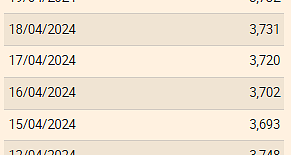For most of the employees ended the recent wage round, with a feeling of Déjà vu: taking into account last year's inflation rate of 0.9 percent, the real income at the beginning of 2019 is not or is only minimally increased. The same was the workforce one year earlier, by the low nominal wage increases were eaten away by price increases. Thus, the purchasing power of private households has been stagnating in Germany since two years – despite a more encouraging economic situation and increasing employment.
How can that be? The employer will see the main reason for the weak wage increases in the modest productivity growth of the domestic economy. "As a result, the room for manoeuvre in wage negotiations is limited," says Simon Wey, labour market economist at the Swiss employers ' Association. Since the financial crisis of 2008/09, Wey, have slowed the development of the labour productivity. This means that For the same number of working hours, the increase of production levels has become smaller and smaller.
a Little cynical, were the employees, the beneficiaries of the Frank shock.
The decline in productivity growth is not about to Switzerland is limited, but a worldwide Trend. The consequences we get to feel it all. Because the wages in step with the productivity of labour, or, as Michael Siegenthaler, labour market expert at the economic research Institute at the ETH Zurich, expressing grow: "The labor productivity in the long term, by far the most important driver of wage growth."
Switzerland as a special case
Given the small Productivity gains in the last few years, low nominal wage surprise increases. In this country the work of participating in the international comparison, even noticeably better dangers. Have sets the wages in the foreign countries in many places, less than the productivity – a result of the relocation of Production in low-wage countries and the recession in the aftermath of the financial crisis. In the result, the Wage share, i.e. the share of labour income in total economic output fell.
According to Marco Salvi, labour market expert at the think tank Avenir Suisse, reported about quotas, two thirds of the countries in the developed world, declining Wages; in the USA and in the UK, the decline was particularly pronounced. "Switzerland is a special case," says Salvi, "it is one of the few countries, where wages have their piece of the overall economic pie by 2017 increased."
Daniel Lampart, chief economist of the Swiss trade Union Federation, agrees: "We were able to keep our share of the pie at least. From a trade Union point of view, this balance sheet for sure." However, he admits immediately: "In the last two pay it is round, Vice versa, wrong, with your output, we can't be satisfied."
in 2012, the cake
How to explain the Swiss exception is increased, which is why the local wage rate of spread could escape the downward trend? A large proportion of that is the strength of the Swiss franc had from 2011 onwards, under the impact of the Euro debt crisis. The strong franc led prices to dramatically decline in Import, which is why Switzerland is recorded in the period from 2012 to 2016 with no or negative inflation. For the employees this had the pleasant effect that their real wage increases were stronger than that of the social partners negotiated nominal wage increases.
This development reached its peak in 2015, the year of the "Frank shock" after the Euro minimum exchange rate had fallen: From an average of 0.4-percent increase in nominal wages and a negative annual inflation of 1.1 percent to a strengthening of the real purchase was the result of force by 1.5 percent. At the same time, labour productivity declined in 2015 compared to the year-on-year by 1.1 percent, as Figures from the Federal office for statistics. The following year, the real wage growth (1.1 percent) was again about the development of productivity (+0.2 percent).
formulated a bit cynically, were they needed to make the employees who are beneficiaries of the Frank shocks – at least those not lost to 2015/16 the place and also not more working hours for the same pay. In these two years, the wage rate in Switzerland has risen noticeably. The same can be said in the years 2011/12 to watch, as the Euro debt crisis was at its most acute. Also at that time, the workers were able to increase their piece of the total economic pie (2013/14 started a slight counter movement).
in 2011/12, as well as 2015/16, the appreciation of the Swiss franc was the driving force in favour of labour income and to the detriment of entrepreneurs and capital income. "The companies have restructured, automated, and certain productions and areas relocated abroad, the currency-related loss of competitiveness to absorb," says Michael Siegenthaler of the business cycle research at the ETH Zurich. Not to be redundancies in greater extent, it, however, because "the employers are to their employees as a Know-how carrier dependent". Siegenthaler speaks in the context of a "hoarding" of employees.
reserve cushion renew
Marco Salvi of Avenir Suisse and argues in a similar direction: "The high qualification level of our population could be a reason why the wage rate in this country is stable." Apparently, Switzerland have found a niche in the production of goods in the highest quality Segment according to the necessary workers were searched, supplemented the Avenir-Suisse representative.
The "hoarding" of employees – the output in better times quickly up and running again – has the result that the labour productivity decreases in recessionary periods. This was because looking back at the last ten years far greater cyclical fluctuations than nominal wages, which rose in a relatively narrow range of 0.4 to 1 percent per year. To put it differently: employers have cushioned the UPS and downs of your income, predominantly at their own expense, by accepted more losses in the profit margins, as the cost of labor to cut down on redundancies.
Older workers a bad way
The consequences of this policy have demonstrated in the past years, Simon Wey from the employers ' Association. The companies would have to reduce their investments and expenditures for research and development. "For the employer, it is in the last round of Wage negotiations in advance how to meet the pent-up demand in investments and the appreciation of the Swiss franc up came to the end of a reserve cushion to rebuild," says Wey.
Daniel Lampart does not acknowledge that "there is room for negotiation in individual companies was due to the pressure on Margins, so gross". At the same time the chief economist of the Confederation of trade unions stresses, however, the "problem of Distribution". To create this again with an eye on inflation, the move for two years to 1 percent – and "the people, including the health insurance premiums a lot more power". On the other, Lampart refers to the older employees: they would be in the case of the increasingly individually granted wage increases in a worse way than younger people. "The recovery", calls for the unionists, "must finally arrive at all."
(editing Tamedia)
Created: 06.02.2019, 11:32 PM

 The Euribor today remains at 3.734%
The Euribor today remains at 3.734% Germany: the trial of an AfD leader, accused of chanting a Nazi slogan, resumes this Tuesday
Germany: the trial of an AfD leader, accused of chanting a Nazi slogan, resumes this Tuesday New York: at Columbia University, the anti-Semitic drift of pro-Palestinian demonstrations
New York: at Columbia University, the anti-Semitic drift of pro-Palestinian demonstrations What is Akila, the mission in which the Charles de Gaulle is participating under NATO command?
What is Akila, the mission in which the Charles de Gaulle is participating under NATO command? What High Blood Pressure Does to Your Body (And Why It Should Be Treated)
What High Blood Pressure Does to Your Body (And Why It Should Be Treated) Vaccination in France has progressed in 2023, rejoices Public Health France
Vaccination in France has progressed in 2023, rejoices Public Health France Food additives suspected of promoting cardiovascular diseases
Food additives suspected of promoting cardiovascular diseases “Even morphine doesn’t work”: Léane, 17, victim of the adverse effects of an antibiotic
“Even morphine doesn’t work”: Léane, 17, victim of the adverse effects of an antibiotic MEPs validate reform of EU budgetary rules
MEPs validate reform of EU budgetary rules “Public Transport Paris 2024”, the application for Olympic Games spectators, is available
“Public Transport Paris 2024”, the application for Olympic Games spectators, is available Spotify goes green in the first quarter and sees its number of paying subscribers increase
Spotify goes green in the first quarter and sees its number of paying subscribers increase Xavier Niel finalizes the sale of his shares in the Le Monde group to an independent fund
Xavier Niel finalizes the sale of his shares in the Le Monde group to an independent fund Owner of Blondie and Shakira catalogs in favor of $1.5 billion offer
Owner of Blondie and Shakira catalogs in favor of $1.5 billion offer Cher et Ozzy Osbourne rejoignent le Rock and Roll Hall of Fame
Cher et Ozzy Osbourne rejoignent le Rock and Roll Hall of Fame Three months before the Olympic Games, festivals and concert halls fear paying the price
Three months before the Olympic Games, festivals and concert halls fear paying the price With Brigitte Macron, Aya Nakamura sows new clues about her participation in the Olympics
With Brigitte Macron, Aya Nakamura sows new clues about her participation in the Olympics Skoda Kodiaq 2024: a 'beast' plug-in hybrid SUV
Skoda Kodiaq 2024: a 'beast' plug-in hybrid SUV Tesla launches a new Model Y with 600 km of autonomy at a "more accessible price"
Tesla launches a new Model Y with 600 km of autonomy at a "more accessible price" The 10 best-selling cars in March 2024 in Spain: sales fall due to Easter
The 10 best-selling cars in March 2024 in Spain: sales fall due to Easter A private jet company buys more than 100 flying cars
A private jet company buys more than 100 flying cars This is how housing prices have changed in Spain in the last decade
This is how housing prices have changed in Spain in the last decade The home mortgage firm drops 10% in January and interest soars to 3.46%
The home mortgage firm drops 10% in January and interest soars to 3.46% The jewel of the Rocío de Nagüeles urbanization: a dream villa in Marbella
The jewel of the Rocío de Nagüeles urbanization: a dream villa in Marbella Rental prices grow by 7.3% in February: where does it go up and where does it go down?
Rental prices grow by 7.3% in February: where does it go up and where does it go down? Europeans: “All those who claim that we don’t need Europe are liars”, criticizes Bayrou
Europeans: “All those who claim that we don’t need Europe are liars”, criticizes Bayrou With the promise of a “real burst of authority”, Gabriel Attal provokes the ire of the opposition
With the promise of a “real burst of authority”, Gabriel Attal provokes the ire of the opposition Europeans: the schedule of debates to follow between now and June 9
Europeans: the schedule of debates to follow between now and June 9 Europeans: “In France, there is a left and there is a right,” assures Bellamy
Europeans: “In France, there is a left and there is a right,” assures Bellamy These French cities that will boycott the World Cup in Qatar
These French cities that will boycott the World Cup in Qatar Serie A: Bologna surprises AS Rome in the race for the C1
Serie A: Bologna surprises AS Rome in the race for the C1 Serie A: Marcus Thuram king of Italy, end of the debate for the position of number 9 with the Blues?
Serie A: Marcus Thuram king of Italy, end of the debate for the position of number 9 with the Blues? Milan AC-Inter Milan: Thuram and Pavard impeccable, Hernandez helpless… The tops and flops of the derby
Milan AC-Inter Milan: Thuram and Pavard impeccable, Hernandez helpless… The tops and flops of the derby Ligue 2: Auxerre leader, Bordeaux in crisis, play-offs... 5 questions about an exciting end of the season
Ligue 2: Auxerre leader, Bordeaux in crisis, play-offs... 5 questions about an exciting end of the season


















